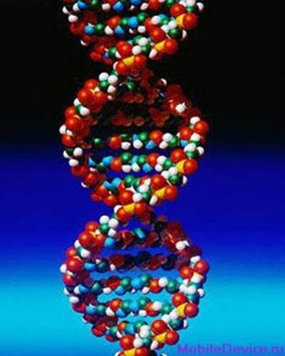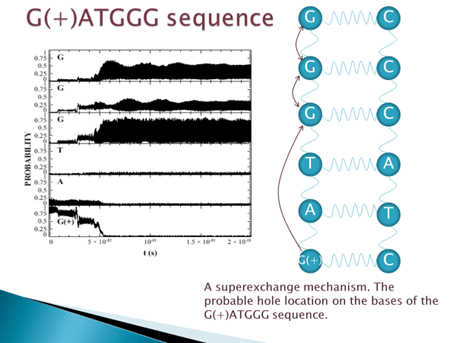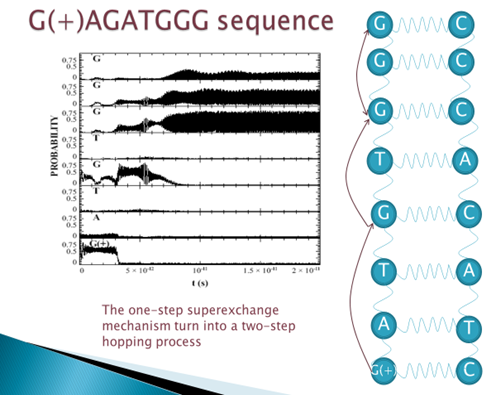Явление декогеренции и квантовые эффекты в сложных, в том числе биологических, структурах
|
|
Sergey Ehduardovich Shirmovsky
Head of Theoretical and Nuclear Physics Chair, Far Eastern Federal University, 8 Sukhanov St., Vladivostok, 690950, Russia. |
Research Units
The decoherence phenomenon and quantum effects in complex, including biological, structures.
DNA
|
Quantum effects’ influence on biological systems functioning has already been discussed for quite a while and proved in the literature. The principal question that arises here is as follows: are quantum effects able to considerably influence biological systems functioning? The problem of charge transfer mechanisms in DNA is quite topical nowadays. It is primarily connected with the fact a charged particle’s impact on DNA triggers mechanisms which play an important part in an organism’s life activity. |
|
|
|
A positive charge transport through a DNA molecule may be followed by quantum tunneling. This demonstrates the DNA capability of supporting a quantum superposition, with the possibility of quantum coherent states being determined by peculiar time scales of different processes in biomolecules and their solutions. |
|
We assume that the investigation demonstrates the utilization of the formalism in practical problems for the study of a charge migration through different molecular sequences that may be tested in experiments. |
|
- S.Eh. Shirmovsky, D.L. Boyda, Study of DNA conducting properties: Reversible and irreversible evolution, Biophysical Chemistry 180-181 (2013) 95-101;
- O. V. Belov, D. L. Boyda, I. Plantec, S. Eh. Shirmovsky, Simulation of the charge migration in DNA under irradiation with heavy ions, Bio-Medical Materials and Engineering 26 (2015) S1937-S1944;
- S.Eh. Shirmovsky, Quantum dynamics of a hole migration through DNA: A single strand DNA model, Biophysical Chemistry 217 (2016) 42–57.
- XXI International Baldin Seminar on High Energy Physics Problems (Baldin ISHEPP XXI) - Relativistic heavy ion collisions, September 10-15 2012, Dubna, Russia. https://pos.sissa.it/173/;
- Molecular Simulation Studies in Material and Biological Sciences, September 9-12, 2012, Dubna, Russia. http://lrb.jinr.ru/conf/mssmbs12/mssmbsE.htmll;
- COMPUTATIONAL AND THEORETICAL MODELING OF BIOMOLECULAR INTERACTIONS, June3–8, 2013, Dubna, Russia. http://www.biomol2013.biophys.msu.ru;
- International Conference "Mathematical Modeling and Computational Physics, 2017" (MMCP2017), 3-7 July 2017, Dubna, Russia; http://indico.jinr.ru/internalPage.py?pageId=8&confId=137
Microtubules
|
Microtubules are an important component of a cell cytoskeleton, including that of neurons. While in cells, microtubules contribute to their integrity and fulfil transport functions such as axon transport of organelles. Also, microtubules are responsible for other kinds of cell activity, including mitosis.
Mechanical properties of the hexagonal microtubules lattice are essential for their functioning in living matter. That is why a considerable number of works are concerned with investigating these characteristics. |
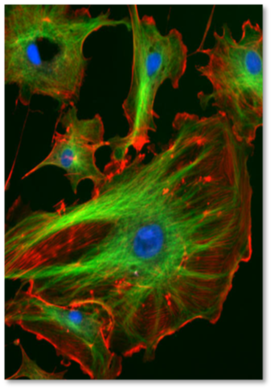
|
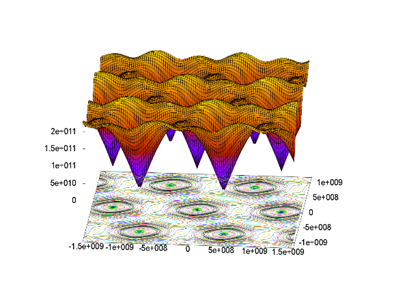
|
The investigation of microtubules properties has become especially topical nowadays in relation to Orch OR Theory by Penrose and Hameroff, who put forward a hypothesis that microtubules may play an important part in forming the phenomenon of consciousness. |
| Investigating the role of quantum effects in microtubules in this case calls for building a model of a microtubule as a macroobject in the first place, whose mechanical properties are to be further investigated on the base of approaches thoroughly considering the influence of some factors, the most important of which are dipole-dipole interaction of tubulins and the viscosity of intracellular environment. |
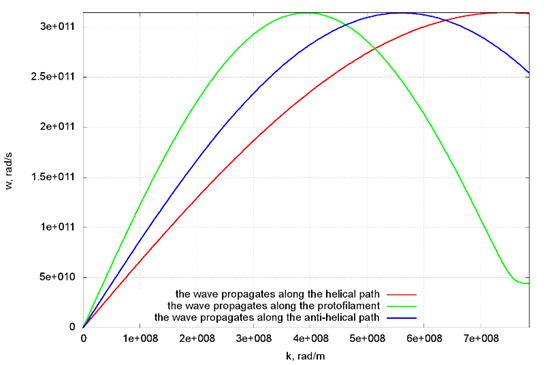
|
- S.Eh. Shirmovsky, D.V. Shulga. Elastic, dipole-dipole interaction and viscosity impact on vibrational properties of anisotropic hexagonal microtubule lattice. BioSystems, Volume 166, 2018, pp. 1–18.
- S.Eh. Shirmovsky, D.V. Shulga. Microtubules lattice equal-frequency maps: The dynamics of relief changes in dependence on elastic properties, tubulins’ dipole–dipole interaction and viscosity. Physica A 534 (2019) 122165
- The Eleventh Workshop on Numerical Methods and Mathematical Modelling in Biology and Medicine, October 11, 2019 http://dodo.inm.ras.ru/biomath-archive/presentationsXI/Shulga.pdf



